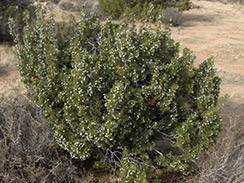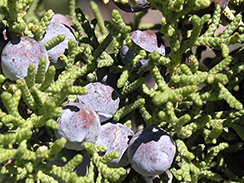Juniper



Juniper is a commonly cultivated ornamental bush in Southern California. But a native variety, Juniperus californica (California Juniper), grows wild on arid rocky slopes in both bush and tree form, from 4′-30′ tall. The evergreen has ashy-gray bark that seems “shredded”, with blueish-gray scaly foliage. California Juniper produces small round “berries” that are actually modified cones, about 1/4″ in diameter, similar in size to blue berries. When young, the berries are whitish green with one immature seed. As the seed ripens, the berry darkens towards blueish red-brown with a “waxy” sheen.
Humans use juniper as both food and medicine. Tribal use included eating the berries dried and fresh, and pounding them into flour meal for mush, sun-dried cakes and baked bread. Medicinally, juniper has diuretic properties, and is used to treat kidney and liver ailments. The Swedes traditionally used juniper extract topically to treat wounds and inflamed joints.
Suggested Culinary Use
Recipe: Juniper Berry Syrup
1 cup sugar
1 cup water
Combine all ingredients in small pot. Bring to boil then simmer 15 to 20 minutes. Remove from heat, transfer to glass bowl, steep in refrigerator for 4+ hours. Strain mixture to discard juniper berry solids.
Recipe: Home-brew Sauerkraut with Juniper Berries
1/2 head red cabbage
1 small red onion
4 medium-size carrots
2 tablespoons salt
4-8 juniper berries pulverized into dry spice
Slice cabbage, carrots and onion into thin ribbons, about 1/8″ wide and 1-4″ long. Place vegis in big mixing bowl, sprinkle salt on top. Massage the salt into the shredded vegis by rubbing and squeezing the cabbage with your hands. Gradually the cabbage will become watery and limp, like coleslaw. Mix in juniper spice. Clean a large mason jar with hot soapy water. Tightly pack the cabbage mixture into the mason jar, packing it down tightly with your clean fist or wooden spoon. You’ll be amazed at how tightly you’re able to pack-down it down, as released-juices rise to cover the tightly-packed vegis.
You could eat your sauerkraut like this, no problemo and tasty indeed. Just keep refrigerated like a salad. Or, you can continue onward with lacto-fermentation for more traditional sauerkraut that will keep longer int he fridge. To lacto-ferment, cover the mouth of the mason jar with a cloth and secure it with a rubber band, letting air flow while keeping dust and insects out. Over the next 24 hours, periodically press down on the vegis encouraging the cabbage to release its liquid and rise over the top of the cabbage. Ferment for 3-10 days, or more if desired, away from direct sunlight and at cool room temperature (ideally 65°F to 75°F). Check daily, pressing down if the cabbage floats above the liquid. You may see bubbles rising up through the cabbage, foam on the top, or white scum. That’s ok, this means healthy fermentation is happening. Skim off the scum during fermentation or before refrigerating. Don’t eat any moldy parts close to the surface. Refrigerate.
